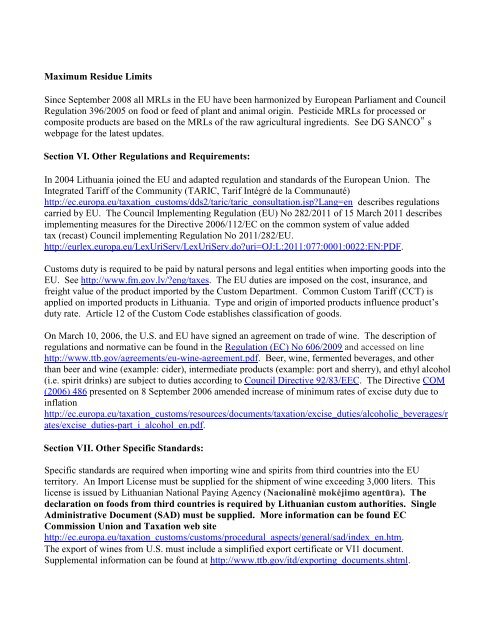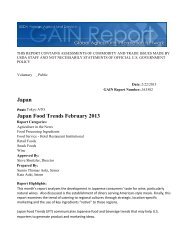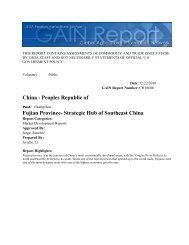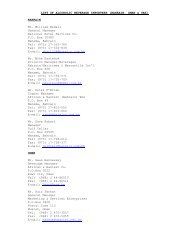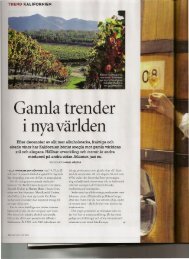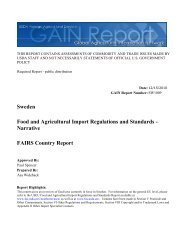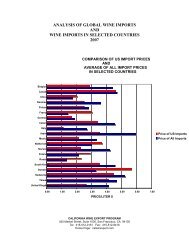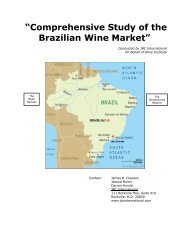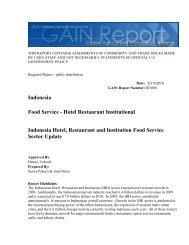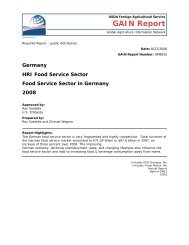FAIRS Country Report Food and Agricultural Import ... - GAIN
FAIRS Country Report Food and Agricultural Import ... - GAIN
FAIRS Country Report Food and Agricultural Import ... - GAIN
You also want an ePaper? Increase the reach of your titles
YUMPU automatically turns print PDFs into web optimized ePapers that Google loves.
Maximum Residue LimitsSince September 2008 all MRLs in the EU have been harmonized by European Parliament <strong>and</strong> CouncilRegulation 396/2005 on food or feed of plant <strong>and</strong> animal origin. Pesticide MRLs for processed orcomposite products are based on the MRLs of the raw agricultural ingredients. See DG SANCO‟ swebpage for the latest updates.Section VI. Other Regulations <strong>and</strong> Requirements:In 2004 Lithuania joined the EU <strong>and</strong> adapted regulation <strong>and</strong> st<strong>and</strong>ards of the European Union. TheIntegrated Tariff of the Community (TARIC, Tarif Intégré de la Communauté)http://ec.europa.eu/taxation_customs/dds2/taric/taric_consultation.jsp?Lang=en describes regulationscarried by EU. The Council Implementing Regulation (EU) No 282/2011 of 15 March 2011 describesimplementing measures for the Directive 2006/112/EC on the common system of value addedtax (recast) Council implementing Regulation No 2011/282/EU.http://eurlex.europa.eu/LexUriServ/LexUriServ.do?uri=OJ:L:2011:077:0001:0022:EN:PDF.Customs duty is required to be paid by natural persons <strong>and</strong> legal entities when importing goods into theEU. See http://www.fm.gov.lv/?eng/taxes. The EU duties are imposed on the cost, insurance, <strong>and</strong>freight value of the product imported by the Custom Department. Common Custom Tariff (CCT) isapplied on imported products in Lithuania. Type <strong>and</strong> origin of imported products influence product’sduty rate. Article 12 of the Custom Code establishes classification of goods.On March 10, 2006, the U.S. <strong>and</strong> EU have signed an agreement on trade of wine. The description ofregulations <strong>and</strong> normative can be found in the Regulation (EC) No 606/2009 <strong>and</strong> accessed on linehttp://www.ttb.gov/agreements/eu-wine-agreement.pdf. Beer, wine, fermented beverages, <strong>and</strong> otherthan beer <strong>and</strong> wine (example: cider), intermediate products (example: port <strong>and</strong> sherry), <strong>and</strong> ethyl alcohol(i.e. spirit drinks) are subject to duties according to Council Directive 92/83/EEC. The Directive COM(2006) 486 presented on 8 September 2006 amended increase of minimum rates of excise duty due toinflationhttp://ec.europa.eu/taxation_customs/resources/documents/taxation/excise_duties/alcoholic_beverages/rates/excise_duties-part_i_alcohol_en.pdf.Section VII. Other Specific St<strong>and</strong>ards:Specific st<strong>and</strong>ards are required when importing wine <strong>and</strong> spirits from third countries into the EUterritory. An <strong>Import</strong> License must be supplied for the shipment of wine exceeding 3,000 liters. Thislicense is issued by Lithuanian National Paying Agency (Nacionalinė mokėjimo agentūra). Thedeclaration on foods from third countries is required by Lithuanian custom authorities. SingleAdministrative Document (SAD) must be supplied. More information can be found ECCommission Union <strong>and</strong> Taxation web sitehttp://ec.europa.eu/taxation_customs/customs/procedural_aspects/general/sad/index_en.htm.The export of wines from U.S. must include a simplified export certificate or VI1 document.Supplemental information can be found at http://www.ttb.gov/itd/exporting_documents.shtml.


